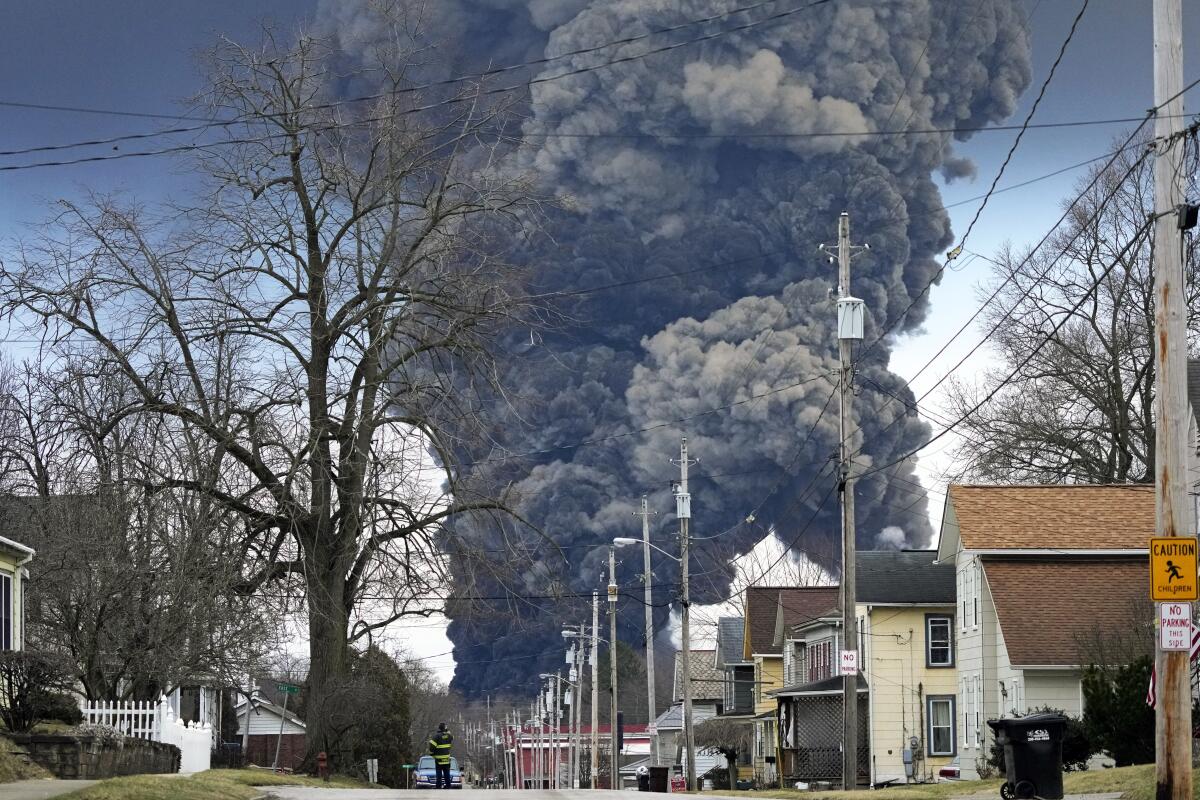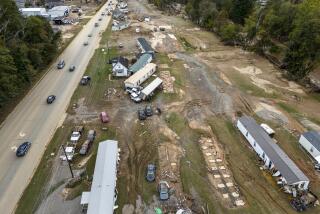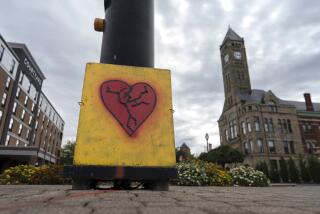Weeks after Ohio rail derailment, President Biden has no plans to visit

WASHINGTON — Republicans are continuing to criticize President Biden for not going to East Palestine, Ohio, where a train carrying toxic, cancer-causing chemicals derailed Feb. 3.
Meanwhile, federal environmental authorities announced Sunday that shipments of contaminated waste out of the site of the fiery accident near the Pennsylvania state line will resume Monday to two approved sites in Ohio.
The announcement came a day after the Environmental Protection Agency, or EPA, ordered Norfolk Southern to “pause” shipments from the derailment site to allow additional oversight measures regarding where the waste was shipped. Some liquid and solid waste had already been taken to sites in Michigan and Texas.
Rather than make a trip to the area, Biden has sent Transportation Secretary Pete Buttigieg and officials from the Federal Emergency Management Agency and the EPA in his stead.
Biden said Friday that he had no plans to visit but emphasized that he has been in close contact with elected officials in the region. His statement came in the wake of withering criticism from Republican foes.
Biden’s visit to Ukraine last week was “the biggest slap in the face,” East Palestine Mayor Trent Conaway, a Republican, told Fox News. “That tells you right now, he doesn’t care about us,” Conaway added, saying he was “furious” the president was in Ukraine “giving millions of dollars away to people over there, not to us.”
“My message to congressional Republicans: you can either be the party of Ukraine & the globalists or you can be the party of East Palestine & the working people of America,” Sen. Josh Hawley, a Missouri Republican, tweeted Friday.
On Friday, House Republicans also launched an oversight investigation into the Department of Transportation’s handling of the disaster.
Biden has bluntly rejected the criticism.
“The idea that we are not engaged is just simply not there,” Biden said. “Initially, there was not a request for me to go out even before I was heading over to Kyiv. I am keeping very close tabs on it. We are doing all we can.”
A White House timeline states that the president’s office reached out by phone to the mayor of East Palestine on four occasions between Feb. 6 and Feb. 17, but it does not indicate that a conversation took place. It also listed a series of calls between Biden and the governors of Ohio and neighboring Pennsylvania.
No one was injured when 38 Norfolk Southern cars derailed in a fiery, mangled mess on the outskirts of town, but as fears grew about a potential explosion due to hazardous chemicals in five of the rail cars, officials evacuated the area. They later opted to release and burn toxic vinyl chloride from the tanker cars, sending flames and black smoke billowing into the sky again.
Some say that Biden’s decision to not visit stands in some contrast to his brand as “comforter in chief.” Biden’s experience has “forged an empathic sensibility that enables him to connect deeply with other Americans through shared grief and pain,” according to a 2021 study by Dan P. McAdams of Northwestern University.
But disaster response is about more than the president personally appearing on scene, Biden administration officials have emphasized. The president has received multiple briefings on the disaster over the last few weeks, dispatched high-level officials including the head of the EPA to the town and talked to the governors while visiting Eastern Europe last week, White House officials noted.
“I think offering the assistance, offering the help is doing it directly,” White House Press Secretary Karine Jean-Pierre said Thursday. “When you are seeing the federal government on the ground, providing the assistance that is needed, that is doing it directly. They are doing it on the direction of the president.”
Republican criticism of Biden’s response to the disaster — and his absence from East Palestine — mounted after former President Trump stopped by the village Wednesday to distribute Trump-branded water and campaign hats to residents. Trump, who is running for president, criticized the government’s handling of the disaster, which he characterized as “indifference and betrayal.”
As president, Trump worked to deregulate the freight railroad industry and scrapped several Obama-era safety protocols.
Republicans have trained much of their criticism of the administration’s response to the disaster on Buttigieg, who visited the site Thursday, a day after Trump. Sen. Marco Rubio (R-Fla.) wrote to Biden this month requesting the Transportation secretary’s resignation. “The circumstances leading up to the derailment point to a clear lack of oversight and demand engagement by our nation’s top transportation official,” he argued.
Buttigieg, who has acknowledged he “could have spoken up sooner” about the disaster, has accused Republicans of taking “political advantage of this situation.”
The public has long expected presidents to play a hands-on role in responding to major disasters. “Disaster management has a place in every president’s White House and personal legacy,” the authors of a 2012 study on the subject concluded. “Disaster management is gradually coming to define an increasing share of [the] presidential image.”
But presidents have tended to stay away in the immediate aftermath of a disaster to prevent their presence and the immense security they require from distracting local officials and first responders.
The president was scheduled to spend the weekend at his home in Delaware. He will travel to Virginia on Tuesday to give a speech about affordable healthcare. But so far, his public schedule includes no plans to visit East Palestine.
More than three weeks have passed since the freight train operated by Norfolk Southern derailed near the Ohio town. Preliminary investigations have found that the accident was “100% preventable.”
Over 40,000 aquatic animals have died in waters near the site of the disaster, officials from the Ohio Department of Natural Resources have said.
Federal and state officials, however, have repeatedly said that it is safe for evacuated residents to return to the site and that air testing in the town and inside hundreds of homes has not detected any concerning levels of contaminants. The state says the local municipal drinking water system is safe, and bottled water is available for those with private wells.
Despite those assurances, many residents have expressed a sense of mistrust or have lingering questions about what they have been exposed to and how it will affect the future of their families and communities.
The Associated Press contributed to this report.
More to Read
Get the L.A. Times Politics newsletter
Deeply reported insights into legislation, politics and policy from Sacramento, Washington and beyond. In your inbox three times per week.
You may occasionally receive promotional content from the Los Angeles Times.











